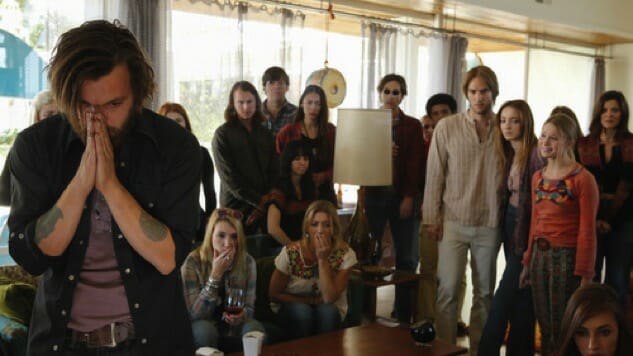King’s Assassination and 5 Times Last Night’s Aquarius Had Us Pulling Out the History Books
(Episode 2.04, “Revolution 1”)

So, you say you want a revolution… Well just make sure you’re prepared for the docudrama that your exploits may inspire years later.
Aquarius makes no argument that it exists firmly within the realm of historical fiction, and for the most part it may seem pretty easy to spot when the show is, well, making it up. Still there are moments where the fictional tales of Hodiak, Emma, Shafe and Charmain blur the line between historical embellishment and historical falsehood. Here are the five moments that sent us diving for our history books in last night’s episode of Aquarius.
1. “They did it. They finally did it. They shot King.”
Of course we all know that this, unfortunately, is all too true. On April 4,1968, Martin Luther King, Jr. was assassinated by James Earl Ray just outside room 306 at the Lorraine Motel in Memphis, Tennessee.
What may come as a surprise is how accurate Aquarius is with not just the actual facts of King’s assassination, but in incorporating those facts into last night’s plot. For example, the police commissioner sends Shafe and Hodiak to talk to Bunchy, with a strong warning that sunset is approaching within the hour. This is a very well executed nod to the fact that King passed away in the evening at 5:05pm. Sunset coming at about 6:30pm in L.A. means that not only is this an accurate timeline, but also serves as a great way to increase tension, without distorting the truth.
On a larger scale we have the riots. Over 100 cities in the Untied States broke out into riots following King’s death. With cities like Chicago, Baltimore and Washington D.C. on the list, it may be a little bit hard to believe that Los Angeles was able to avoid the destruction. Surprisingly, that’s absolutely true. While many cities experienced devastating violence as a result of the outpouring of grief and frustration many felt after King’s murder, Los Angeles was spared. A joint effort between the Los Angeles Police Department and community organizers like the Black Panther Party kept violence to a minimum. It was a bit more of a group effort than just sending our two wayward heroes down to Watts for the day, but I guess we can forgive them a little logic leap for the sake of dramatic tension.
![]()
2. Jeff Schneider and Louisa Burnside
Ahhhh, young love… and the murder that television loves telling us is so often the outcome. With as emotionally grounded and socially complex a story as Louisa Burnside’s murder provides, you wouldn’t be foolish for thinking there might be at least a little bit of historical accuracy to this story.
It certainly matches up with the social complexities and tensions of the time. But despite the Law & Order feel to this plot line, it was not in fact ripped from the headlines. As far as we can tell, there was never a Louisa Burnside or Jeff Schneider, nor was there any incident like the one depicted at the time our story is set. So, while this plot may be effective storytelling, a story is all it is.
